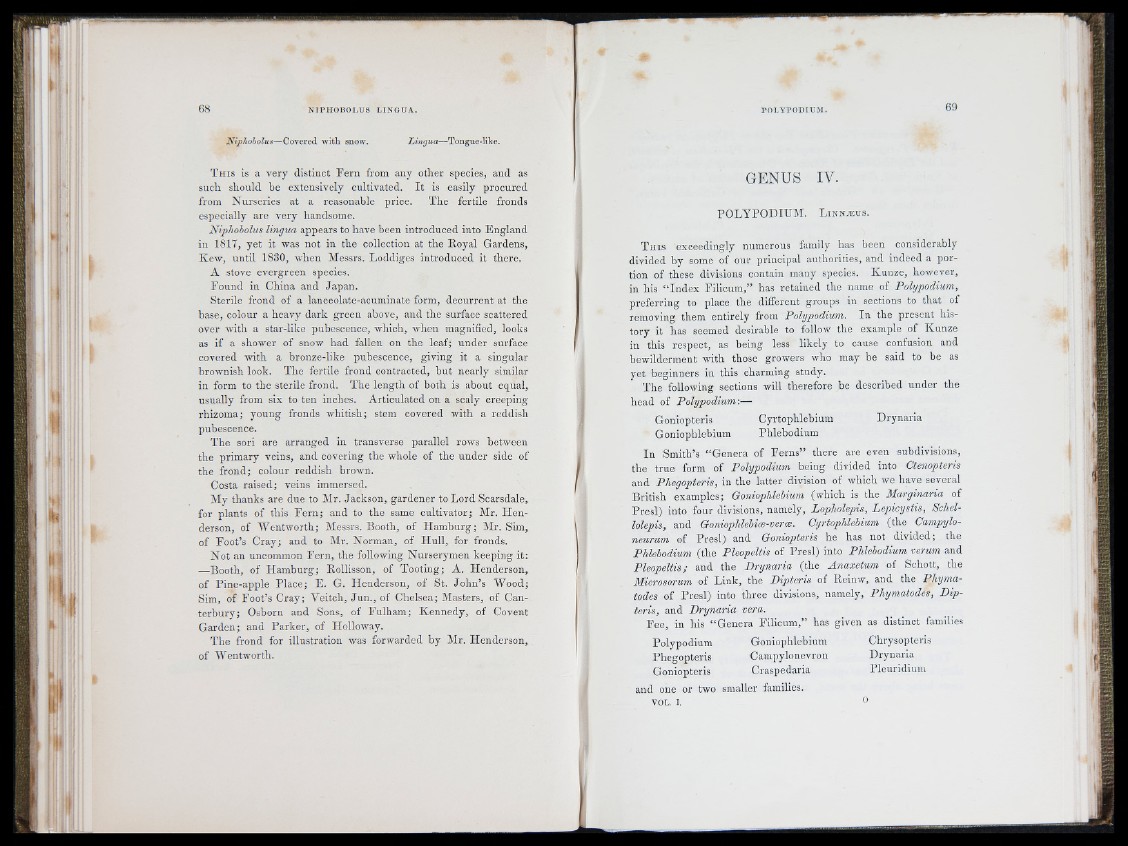
'I !
Nlpkobohis—Covered witli snow. L in g u a—-Tongue-like.
T h i s is a very distinct P e rn from any other species, and a s
such should be extensively cultivated. I t is easily procured
from Nurse rie s at a reasonable price. The fertile fronds
especially are very handsome.
Niphoholus lingua appears to have been introduc ed into E n g la n d
in 1817, y e t it was not in the collection at the Iloyal Gardens,
K ew, u ntil 1880, when Messrs. Loddiges introduc ed it there.
A stove evergreen species.
F o u n d in China and Japan.
Sterile frond of a lanceolate-acuminate form, d e cu rren t at the
base, colour a heavy dark green above, and the surface scattered
over -with a star-like pubescence, which, when magnified, looks
as if a shower of snow h ad fallen on the leaf; un d e r surface
covered with a bronze-like pubescence, giving- it a singular
brownish look. T h e fertile frond contracted, b u t nearly similar
iii form to the sterile frond. The len g th of both is about equal,
usually from six to ten inches. Articu la ted on a scaly creeping
rhizoma; young fronds whitish; stem covered with a reddish
pubescence.
T h e sori are arranged in transverse p a rallel rows between
the prima ry veins, and covering the whole of the u n d e r side of
the fro n d ; colour reddish brown.
Costa raised; veins immersed.
M y thanks are due to Mr. Ja ckson, g a rdener to L o rd Scarsdale,
for plants of this F e rn ; and to the same cultivator; Mr. lie n -
derson, of W en tw o rth ; Messrs. Booth, of H am b u rg ; Mr. Sim,
of P o o t’s C ray ; and to Mr. Norman, of H u ll, for fronds.
N o t an uncommon P e rn , the following N u rserymen keeping it;
—Booth, of H am b u rg ; Rollisson, of T o o tin g ; A. H en derson,
of P ine-apple P la c e ; E. G. H en d e rso n , of St. Jo h n ’s Wo o d ;
Sim, of F o o t’s C ray ; Veitch, Ju n ., of Chelsea; Masters, of Cante
rb u ry ; Osborn and Sons, of F u lh am ; K en n ed y , of Covent
G a rd en ; and P a rk e r, of Holloway.
T h e frond for illustration was forwarded b y Mr. Henderson,
of Wentworth.
GENUS IV.
PO L V PO D IUM . L i n n æ u s .
T h i s exceedingly numerous family has been considerably
divided by some of our principal authorities, and indeed a p o rtion
of these divisions contain many species. K u n z e , however,
in his “ In d ex Pilicum ,” has retained the name of Polypodium,
p refe rring to place the different groups in sections to th a t of
removing them entirely from Polypodium. In the present history
it has seemed desirable to follow the example of Kunze
in this respect, as being less likely to cause confusion and
bewilderment with those growers who may be said to be as
yet beginners in this charming study.
T h e following sections will therefore he described u n d e r the
head of P o ly p o d ium -.—
Goniopteris Cyrtophlehium D ry n a rla
Goniophlebium Phlebodium
In Smith’s “ Genera of F e rn s” there are even subdivisions,
the tru e form of Polypodium being divided into Ctenopteris
and Pliegopteris, in the latter division of which we have several
British examples; Gonioplilehium (which is the Marginaria of
P re sl) into four divisions, namely, Lopholepis, Lep ic y stis, Schel-
lolepis, and Goniophlebiæ-veræ. Cyrtophlehium (the Campylo-
neurum of P re sl) and Goniopteris he has not div id ed ; the
Phlebodium (the Pleopeltis of P re sl) into Phlebodium verum and
Pleopeltis; and the D ryn a ria (the A n a x e tum of Schott, the
Microsorum of L in k , the Dipteris of Reinw, and the P h ym a todes
of P re sl) into th re e divisions, namely, Phymatodes, D ip teris,
and D r yn a ria vera.
Fe e , in his “ Genera Pilicum,” has given as distinct families
Polypodium Goniophlebium Chrysoptcris
Phegopteris Campylonevron D ry n a ria
Goniopteris Craspedaria Pleu rid ium
and one or two smaller families.
VO L . I, 0